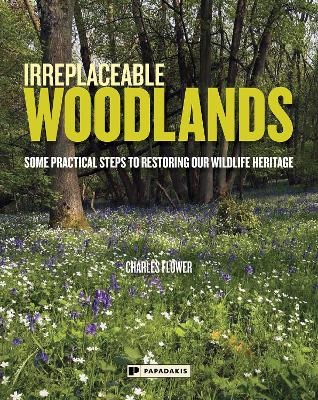
Irreplaceable Woodlands
Papadakis (Verlag)
978-1-906506-53-7 (ISBN)
Charles Flower is passionate about restoring the countryside. He has spent many years working on and writing about the restoration of wild flowers to grasslands and has now turned his attention to ancient woodlands, many of which, though derelict, are treasure houses of diversity, an asset unrecognised by almost everyone including those in Government. Yet with a little effort glades and rides, which may represent less than ten per cent of the wood, can be opened up with remarkable results. Once light penetrates some wild flowers will reappear and attract back the insects, birds and animals that once flourished there. What is more, over the last twenty years some 85,000 hectares of new broad-leaved woodland have been planted in England most of it devoid of wildlife, a giant missed opportunity since this land, which greatly exceeds the area of the nature reserves of all the English Wildlife Trusts, is protected from agricultural agrochemicals and would provide the perfect breeding ground for wild flower diversity and the insect, bird and animal life associated with it. Just as introducing the right methods was the key to creating successful wild flower headlands on agricultural land, introducing appropriate methods will establish wild flowers in new woods.
This book is not only a beautiful record of the ancient woodlands that, thanks to good management, have continued to thrive, it also constitutes a practical manual and provides inspiration for those working to preserve our existing ancient woodlands and those managing recently planted woods and planting the trees that will constitute our future woodland heritage.
Charles Flower is a consultant working with individuals, farmers and landowners as well as parishes and other groups to safeguard wild flowers and increase plant and animal diversity. He manages his own 25 acre hazel copse. His first book 'Where Have all the Flowers Gone? Restoring Wild Flowers to the Countryside' was published to great acclaim in 2008.
CHAPTER 1: INTRODUCTION
How to maintain the incredible diversity of an ancient woodland
CHAPTER 2: HISTORY OF MAPLEASH COPSE
The fascinating history of the copse managed by Charles Flower and an overview of the woodland clearance since
Man’s earliest farming.
CHAPTER 3: MEDIEVAL WOODLAND PRODUCTS
How the key species of oak, ash and hazel supplied the essentials of medieval rural life.
CHAPTER 4: WOODLAND TREES AND SHRUBS
The most important species of trees and shrubs, their characteristics and dispersal strategies.
CHAPTER 5: RESTORING DERELICT HAZEL
A detailed account of the techniques required to restore a derelict hazel copse with all the trials and tribulations of
outwitting deer and rabbits.
CHAPTER 6: DEAD WOOD, CAVITIES AND FUNGI
The vitally important role of dead wood, standing and fallen, with descriptions of some of the extraordinary fungi which
help convert dead wood into woodland soil.
CHAPTER 7: WOODLAND WILD FLOWERS
A detailed account of the wild flowers, 90 per cent of which depend on rides and glades for their survival, and the
effects of coppicing on the ground flora.
CHAPTER 8: FERNS, MOSSES AND LIVERWORTS
The amazing world of ferns, mosses and lichens and how to encourage these often over-looked organisms.
CHAPTER 9: INSECTS
A photographic glimpse of the fascinating insects that inhabit ancient woodland and their specialised requirements.
CHAPTER 10: OTHER OCCUPANTS OF THE WOOD
The rich diversity of animal life in an ancient woodland, much of which is nocturnal, from birds to dormice and
badgers, and the clues to its presence.
CHAPTER 11: MANAGING A WOOD FOR DIVERSITY
Nine practical steps to safeguarding the diversity of the woodland including the detailed management of rides and
glades.
CHAPTER 12: ESTABLISHING WILD FLOWERS IN WOODLAND AND GARDENS
How to encourage wild flowers in new broad-leaved woodland when shade levels develop and how woodland wild
flowers can solve gardeners’ shade problems, while also establishing a vital nectar supply for wildlife.
| Erscheint lt. Verlag | 1.6.2024 |
|---|---|
| Zusatzinfo | 21 Illustrations, black and white; 470 Illustrations, color |
| Verlagsort | Newbury |
| Sprache | englisch |
| Maße | 265 x 210 mm |
| Gewicht | 1042 g |
| Themenwelt | Sachbuch/Ratgeber ► Gesundheit / Leben / Psychologie |
| Naturwissenschaften ► Biologie ► Ökologie / Naturschutz | |
| Naturwissenschaften ► Geowissenschaften ► Geografie / Kartografie | |
| Weitere Fachgebiete ► Land- / Forstwirtschaft / Fischerei | |
| ISBN-10 | 1-906506-53-1 / 1906506531 |
| ISBN-13 | 978-1-906506-53-7 / 9781906506537 |
| Zustand | Neuware |
| Informationen gemäß Produktsicherheitsverordnung (GPSR) | |
| Haben Sie eine Frage zum Produkt? |
aus dem Bereich


